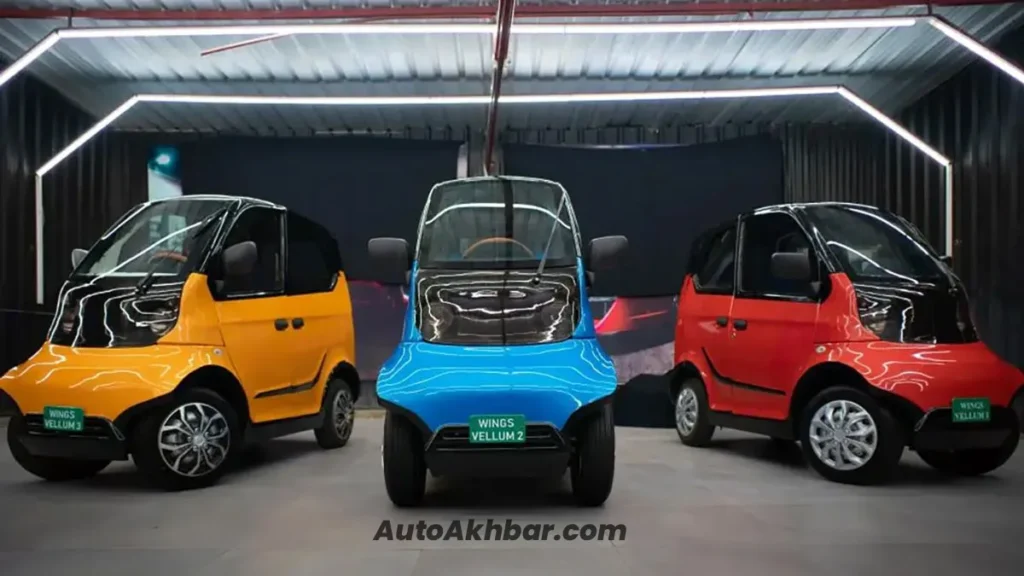Introduction
Have you ever imagined a car that’s smaller than a Tata Nano yet safer than a bike? Meet Wings Robin, a revolutionary electric microcar created by an Indian startup — Wings EV. Designed to make daily commuting safer and more convenient, this two-seater EV might just change how Indians travel through congested city roads.

Table of Contents
Wings Robin isn’t just cute — it’s smart, efficient, and built for the future. And yes, it’s half the size of the Nano!
1. Compact Yet Smart Design
At first glance, the Wings Robin looks like a toy car, but step closer, and you’ll realize it’s a well-engineered micro EV built to replace two-wheelers.
- The prototype version features Rolls-Royce-style doors, opening opposite ways for easy entry.
- The final production model will have one front door for the driver and one rear door for the passenger for better practicality.
- Despite its small size, the car feels surprisingly spacious inside — even a 6-foot-tall person can sit comfortably in the front seat!
The paint quality and finish are impressive for a prototype. A large black front panel covers the headlights and indicators, giving it a futuristic look.
2. Features and Specifications
| Specification | Details |
|---|---|
| Seating Capacity | 2 persons |
| Top Speed | 60 km/h |
| Range per Charge | 65–90 km (depending on variant) |
| Battery Type | Lithium Ferrous Phosphate (LFP) |
| Charging Port | Type-2 compatible; easy home charging |
| Ground Clearance | Optimized for Indian roads |
| Safety | Crash-tested, seatbelts, automatic braking system |
| Comfort Features | AC, USB charging port, wipers, glass roof, adjustable fan modes |
| Steering System | Electric with horn and neutral/reverse/drive dial |
| Braking System | Regenerative + Auto braking when throttle released |
3. Built for Indian Roads
The Robin has been designed keeping India’s traffic and road conditions in mind. The high ground clearance ensures that speed breakers and potholes don’t scrape the underside.
When driving, the auto-braking feature makes city commutes effortless. Lift your foot off the accelerator, and the car gently slows down — a small but genius addition.
Its U-turn radius is incredibly tight, making it ideal for narrow lanes and crowded parking lots. In fact, the Robin can take a complete U-turn in the space where a big car barely moves!
4. Battery Innovation – The World’s Thinnest EV Battery
According to Wings EV’s co-founder Pranav, the Robin uses the world’s thinnest EV battery pack — just 69mm thick. This pack sits under the floor, giving:
- A low center of gravity for better handling
- More interior space
- Better balance and safety
The battery uses LFP cells, which are safer and more stable under Indian climate conditions. They’ve passed all required battery safety certifications and crash tests.
5. Driving Experience
During the test drive, the Wings Robin impressed with its smooth, silent, and stable performance.
- The EV glides quietly — no vibration, no engine noise.
- Auto braking kicks in smoothly, especially useful in stop-and-go traffic.
- The AC is powerful for its size, and USB charging makes it practical for daily users.
The top speed is 60 km/h, making it perfect for urban driving. On highways, it might feel limited — but it was never designed for speed; it’s about smart mobility.
2026 Sundak Electric Car India Launch
6. Challenges Ahead
While the Robin is exciting, success in India will depend on a few key factors:
- Pricing — It needs to be affordable enough to attract two-wheeler buyers.
- Charging & Service Network — Wider accessibility will build confidence among early adopters.
- Public Perception — Indians must view it as a smart city car, not a “toy vehicle.”
- Safety Assurance — Continued focus on real-world crash safety and reliability.
7. Why Wings Robin Could Be a Game-Changer
India has millions of two-wheelers on roads — but they’re not the safest option. Tata tried solving this with the Nano, but the concept was misunderstood.
Now, Wings EV is reviving that vision with Robin — offering the safety of a car, mobility of a bike, and the eco-friendliness of an EV.
If priced around ₹2–3 lakhs, this could easily become India’s next big urban mobility success.
8. Final Thoughts
The Wings Robin represents India’s innovation spirit — a blend of compact design, safety, and sustainable technology. It’s not just a car; it’s a movement towards safer, cleaner, and smarter city travel.
When it officially launches, it might just redefine what we think a “small car” can do.
FAQ Wings Robin EV
What is the Wings Robin Electric Car?
The Wings Robin is India’s smallest and most affordable electric microcar designed for urban commuters. It offers the comfort of a car and the efficiency of an electric scooter, making it ideal for short city trips and daily commutes.
What is the price of the Wings Robin EV in India?
The expected price of the Wings Robin Electric Car is around ₹2.5 lakh to ₹3 lakh (ex-showroom). The company aims to make it an accessible option for two-wheeler users who want to switch to four-wheeler EV mobility.
What is the driving range of the Wings Robin EV?
The Wings Robin offers an estimated range of 80–100 km per charge, depending on the driving mode and battery configuration. It’s perfect for city driving, school runs, and short-distance travel.
How long does it take to charge the Wings Robin?
The Robin can be fully charged in about 3 to 4 hours using a standard household socket. It also supports portable charging, allowing users to plug it in anywhere convenient.
Is the Wings Robin safe for city driving?
Yes, the Robin is designed with a sturdy steel frame, seat belts, LED lights, and a closed cabin, ensuring safety from weather and minor collisions. While it’s not highway-rated, it’s ideal for short-distance urban mobility.